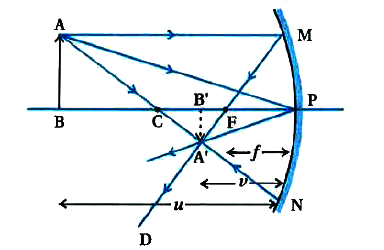Answer the following questions:
(d) Why must both the objective and the eyepiece of a compound microscope have short focal lengths? Solution in Gujrati
The angular magnification of eye-piece is
(25fe+1) . If fe is smaller then angular magnification increases.
⇒ Also, magnifcation of objective is
v0|u0|=1(|u0|/f0)−1 where f0 is less than |u0|, then it is large . To observe the very nearer objects, microscope is use. Hence, |u0| is small but f0 is smaller.
Topper's Solved these Questions
- RAY OPTICS AND OPTICAL INSTRUMENTSBOOK - KUMAR PRAKASHANCHAPTER - RAY OPTICS AND OPTICAL INSTRUMENTSEXERCISE - SECTION-B (NUMERICALS)(NUMERICAL FROM .DARPAN. BASED ON TEXTBOOK )
12 Videos
- RAY OPTICS AND OPTICAL INSTRUMENTSBOOK - KUMAR PRAKASHANCHAPTER - RAY OPTICS AND OPTICAL INSTRUMENTSEXERCISE - SECTION-C (NCERT EXEMPLAR SOLUTION) (MULTIPLE CHOICE QUESTIONS (MCQs))
16 Videos
- RAY OPTICS AND OPTICAL INSTRUMENTSBOOK - KUMAR PRAKASHANCHAPTER - RAY OPTICS AND OPTICAL INSTRUMENTSEXERCISE - SECTION-B (NUMERICALS)(NUMERICAL FROM TEXTUAL ILLUSTRATIONS)
17 Videos
- MOVING CHARGES AND MAGNETISMBOOK - KUMAR PRAKASHANCHAPTER - MOVING CHARGES AND MAGNETISMEXERCISE - SECTION D (MCQs ASKED IN COMPETITIVE EXAMS)
34 Videos
- SAMPLE QUESTION PAPER BOOK - KUMAR PRAKASHANCHAPTER - SAMPLE QUESTION PAPER EXERCISE - PART-B SECTION-C
5 Videos
Similar Questions
As shown in the figure, a thin rod AB of length 10 cm is placed on the principal axis of a concave mirror such that it.s end B is at a distance of 40 cm from the mirror. If the focal length of the mirror is 20 cm, find the length of the image of the rod

View SolutionA ray of light incident at an angle θ on a refracting face of a prism emerges from the other face normally. If the angle of the prism is 5∘ and the prism is made of a material of refractive index 1.5, the angle of incidence is
View SolutionSuppose that the lower half of the concave mirror.s reflecting surface as shown in figure is covered with an opaque (non-reflective) material. What effect will this have on the image of an object placed in front of the mirror ?

View SolutionElectric charge Q having mass M moves on a circular path of radius R with velocity →v, perpendicular to uniform magnetic field B. When a particle completes one revolution, work done by the field is _______
View SolutionTwo charges –q and +q are located at points (0, 0, –a) and (0, 0, a), respectively.
(a) What is the electrostatic potential at the points (0, 0, z) and (x, y, 0) ?
(b) Obtain the dependence of potential on the distance r of a point from the origin when r/a>>1 .
(c) How much work is done in moving a small test charge from the point (5,0,0) to (–7,0,0) along the x-axis? Does the answer change if the path of the test charge between the same points is not along the x-axis?
View SolutionObjective of a compound microscope should have small focal length. Why ?
View Solutiond) Why must both the objective and the eyepiece of a compound microscope have short focal lengths ?
View SolutionTo increase magnification of a compound microscope , the objective and the eyepiece of …. Focal lengths and the microscope tube of ….. Length are to be taken [fill in the blanks] .
View SolutionDefine the magnifying power of a compound microscope when the final image is formed at infinity . Why must both the objective and the eyepiece of a compound microscope has short focal lengths ? Explain.
View SolutionDefine the magnifying power of a compound microscope when thefinal image is formed at infinity. Why must both the objective and the eyepiece of a compound microscope has short focal lengths? Explain.
View SolutionWhy must both the objective and the eyepiece of a compound microscope have short focal lengths?
View SolutionAnswer the following questions:
(d) Why must both the objective and the eyepiece of a compound microscope have short focal lengths?
View SolutionAnswer the following questions:
(d) Why must both the objective and the eyepiece of a compound microscope have short focal lengths?
View Solution(i) Draw a neat labelled ray diagram of a compound microscope. Explain briefly its working. (ii) Why must both the objective and the eye-piece of a compound microscope have short focal lengths ?
View SolutionAnswer the following questions:
(d) Why must both the objective and the eyepiece of a compound microscope have short focal lengths?
View SolutionDefine the magnifying power of a compound microscope when the final image is formed at infinity. Why must both the objective and the eyepiece of a compound microscope has short focal lengths ? Explain.
View Solution
